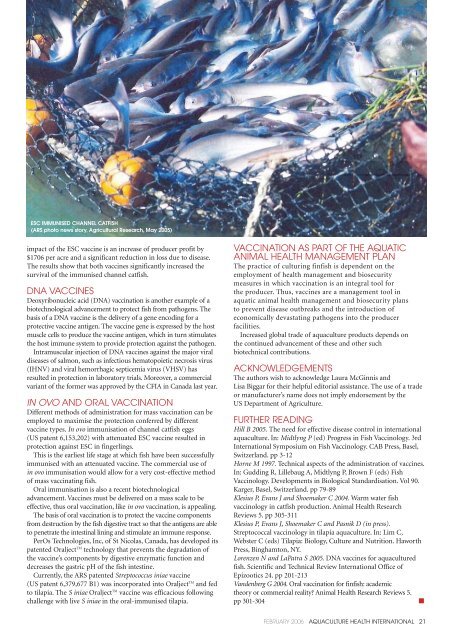aquaculturehealth - Montana Water Center - Montana State University
aquaculturehealth - Montana Water Center - Montana State University
aquaculturehealth - Montana Water Center - Montana State University
You also want an ePaper? Increase the reach of your titles
YUMPU automatically turns print PDFs into web optimized ePapers that Google loves.
ESC IMMUNISED CHANNEL CATFISH<br />
(ARS photo news story, Agricultural Research, May 2005)<br />
impact of the ESC vaccine is an increase of producer profit by<br />
$1706 per acre and a significant reduction in loss due to disease.<br />
The results show that both vaccines significantly increased the<br />
survival of the immunised channel catfish.<br />
DNA VACCINES<br />
Deoxyribonucleic acid (DNA) vaccination is another example of a<br />
biotechnological advancement to protect fish from pathogens. The<br />
basis of a DNA vaccine is the delivery of a gene encoding for a<br />
protective vaccine antigen. The vaccine gene is expressed by the host<br />
muscle cells to produce the vaccine antigen, which in turn stimulates<br />
the host immune system to provide protection against the pathogen.<br />
Intramuscular injection of DNA vaccines against the major viral<br />
diseases of salmon, such as infectious hematopoietic necrosis virus<br />
(IHNV) and viral hemorrhagic septicemia virus (VHSV) has<br />
resulted in protection in laboratory trials. Moreover, a commercial<br />
variant of the former was approved by the CFIA in Canada last year.<br />
IN OVO AND ORAL VACCINATION<br />
Different methods of administration for mass vaccination can be<br />
employed to maximise the protection conferred by different<br />
vaccine types. In ovo immunisation of channel catfish eggs<br />
(US patent 6,153,202) with attenuated ESC vaccine resulted in<br />
protection against ESC in fingerlings.<br />
This is the earliest life stage at which fish have been successfully<br />
immunised with an attenuated vaccine. The commercial use of<br />
in ovo immunisation would allow for a very cost-effective method<br />
of mass vaccinating fish.<br />
Oral immunisation is also a recent biotechnological<br />
advancement. Vaccines must be delivered on a mass scale to be<br />
effective, thus oral vaccination, like in ovo vaccination, is appealing.<br />
The basis of oral vaccination is to protect the vaccine components<br />
from destruction by the fish digestive tract so that the antigens are able<br />
to penetrate the intestinal lining and stimulate an immune response.<br />
PerOs Technologies, Inc, of St Nicolas, Canada, has developed its<br />
patented Oralject TM technology that prevents the degradation of<br />
the vaccine’s components by digestive enzymatic function and<br />
decreases the gastric pH of the fish intestine.<br />
Currently, the ARS patented Streptococcus iniae vaccine<br />
(US patent 6,379,677 B1) was incorporated into Oralject TM and fed<br />
to tilapia. The S iniae Oralject TM vaccine was efficacious following<br />
challenge with live S iniae in the oral-immunised tilapia.<br />
VACCINATION AS PART OF THE AQUATIC<br />
ANIMAL HEALTH MANAGEMENT PLAN<br />
The practice of culturing finfish is dependent on the<br />
employment of health management and biosecurity<br />
measures in which vaccination is an integral tool for<br />
the producer. Thus, vaccines are a management tool in<br />
aquatic animal health management and biosecurity plans<br />
to prevent disease outbreaks and the introduction of<br />
economically devastating pathogens into the producer<br />
facilities.<br />
Increased global trade of aquaculture products depends on<br />
the continued advancement of these and other such<br />
biotechnical contributions.<br />
ACKNOWLEDGEMENTS<br />
The authors wish to acknowledge Laura McGinnis and<br />
Lisa Biggar for their helpful editorial assistance. The use of a trade<br />
or manufacturer’s name does not imply endorsement by the<br />
US Department of Agriculture.<br />
FURTHER READING<br />
Hill B 2005. The need for effective disease control in international<br />
aquaculture. In: Midtlyng P (ed) Progress in Fish Vaccinology. 3rd<br />
International Symposium on Fish Vaccinology. CAB Press, Basel,<br />
Switzerland. pp 3-12<br />
Horne M 1997. Technical aspects of the administration of vaccines.<br />
In: Gudding R, Lillebaug A, Midtlyng P, Brown F (eds) Fish<br />
Vaccinology. Developments in Biological Standardisation. Vol 90.<br />
Karger, Basel, Switzerland. pp 79-89<br />
Klesius P, Evans J and Shoemaker C 2004. Warm water fish<br />
vaccinology in catfish production. Animal Health Research<br />
Reviews 5. pp 305-311<br />
Klesius P, Evans J, Shoemaker C and Pasnik D (in press).<br />
Streptococcal vaccinology in tilapia aquaculture. In: Lim C,<br />
Webster C (eds) Tilapia: Biology, Culture and Nutrition. Haworth<br />
Press, Binghamton, NY.<br />
Lorenzen N and LaPatra S 2005. DNA vaccines for aquacultured<br />
fish. Scientific and Technical Review International Office of<br />
Epizootics 24. pp 201-213<br />
Vandenberg G 2004. Oral vaccination for finfish: academic<br />
theory or commercial reality Animal Health Research Reviews 5.<br />
pp 301-304<br />
■<br />
FEBRUARY 2006 AQUACULTURE HEALTH INTERNATIONAL 21






